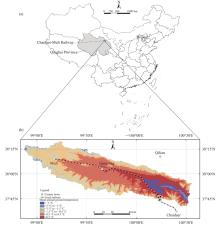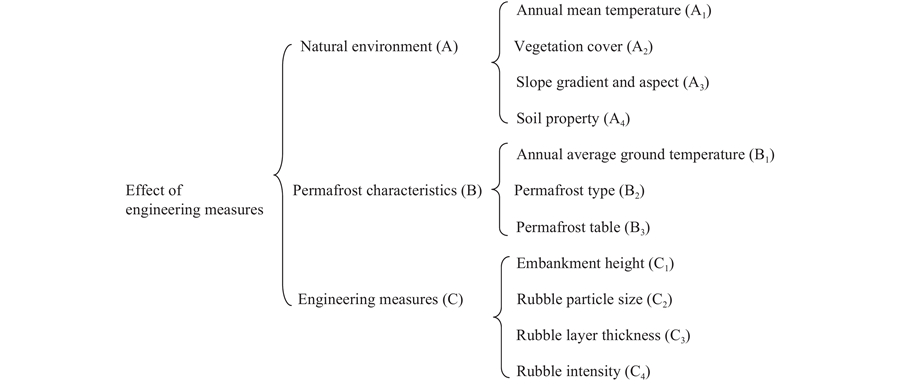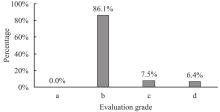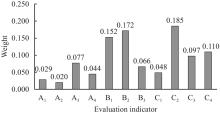Sciences in Cold and Arid Regions ›› 2018, Vol. 10 ›› Issue (6): 447–457.doi: 10.3724/SP.J.1226.2018.00447
• • 下一篇
Applying the AHP-FUZZY method to evaluate the measure effect of rubble roadbed engineering in permafrost regions of Qinghai-Tibet Plateau: a case study of Chaidaer-Muli Railway
Wei Cao,Yu Sheng*( ),Ji Chen,JiChun Wu
),Ji Chen,JiChun Wu
- State Key Laboratory of Frozen Soil Engineering, Northwest Institute of Eco-Environment and Resources, Chinese Academy of Sciences, Lanzhou, Gansu 730000, China
| 1 | Cao W, Sheng Y, Qin YH, 2009. AHP for the assessment of permafrost environment in Muli mining area of Qinghai Province, China. In: Proceedings of the 14th Conference on Cold Regions Engineering. Duluth, MN: ASCE, pp. 201–211. DOI: 10.1061/41072(359)23. |
| 2 |
Chen J, Song RF, Sheng Y, et al. Cooling effect of measures for rubble subgrade convection of Chaidaer-Muli Railway. Journal of Railway Engineering Society 2011; 28: 5 40- 44, 55.
doi: 10.3969/j.issn.1006-2106.2011.05.009 |
| 3 |
Chen L, Yu WB, Han FL, et al. Impacts of Aeolian sand on cooling effect of crushed-rock embankment of Qinghai-Tibet Railway. Journal of Glaciology and Geocryology 2015; 37: 1 147- 155.
doi: 10.7522/j.issn.1000-0240.2015.0016 |
| 4 |
Chen Q, Hu K, Luo KL, et al. Study on the synthetical assessment model of mine eco-environments based on AHP. Journal of China University of Mining & Technology 2006a; 35: 3 377- 383.
doi: 10.3321/j.issn:1000-1964.2006.03.018 |
| 5 |
Chen TF, Cui P, Yao LK Impact of highway engineering construction on geological environment in southwest mountain area: fuzzy synthetic evaluation. Journal of Natural Disasters 2006b; 15: 3 8- 13.
doi: 10.3969/j.issn.1004-4574.2006.03.002 |
| 6 |
Cheng GD A roadbed cooling approach for the construction of Qinghai-Tibet Railway. Cold Regions Science and Technology 2005a; 42: 2 169- 176.
doi: 10.1016/j.coldregions.2005.01.002 |
| 7 |
Cheng GD Constructing of the Qinghai-Tibet Railroad using the principle of cooling the roadbed. Journal of Glaciology and Geocryology 2005b; 27: 1 1- 7.
doi: 10.3969/j.issn.1000-0240.2005.01.001 |
| 8 |
Cheng GD, Ma W Permafrost engineering problems in the construction of the Qinghai-Tibet Railway. Chinese Journal of Nature 2006; 28: 6 315- 320.
doi: 10.3969/j.issn.0253-9608.2006.06.002 |
| 9 |
Hou YD, Wu QB, Sun ZZ, et al. The coupled reinforcing effect of crushed rock slope protection and thermosyphons in Qinghai-Tibet Railway. Journal of Glaciology and Geocryology 2015; 37: 1 118- 125.
doi: 10.7522/j.issn.1000-0240.2015.0012 |
| 10 |
Lai YM, Zhang LX, Xu WZ, et al. Temperature features of broken rock mass embankment in the Qinghai-Tibetan Railway. Journal of Glaciology and Geocryology 2003; 25: 3 291- 296.
doi: 10.3969/j.issn.1000-0240.2003.03.009 |
| 11 |
Ma W, Wu QB, Cheng GD Analyses of the temperature fields within an air convective embankment of crushed rock structure along the Qinghai-Tibet Railway. Journal of Glaciology and Geocryology 2006; 28: 4 586- 595.
doi: 10.3969/j.issn.1000-0240.2006.04.019 |
| 12 |
Niu FJ, Liu MH, Cheng GD, et al. Long-term thermal regimes of the Qinghai-Tibet Railway embankments in plateau permafrost regions. Science China Earth Sciences 2015; 58: 9 1669- 1676.
doi: 10.1007/s11430-015-5063-0 |
| 13 |
Sheng Y, Zhang JM, Liu YZ, et al. Thermal regime in the embankment of Qinghai-Tibetan Highway in Permafrost regions. Cold Regions Science and Technology 2002; 35: 1 35- 44.
doi: 10.1016/S0165-232X(02)00026-5 |
| 14 |
Sun ZZ, Ma W, Li DQ Study of adjusting temperature effect of ripped-rock in-situ. Rock and Soil Mechanics 2006; 27: 11 2001- 2004.
doi: 10.3969/j.issn.1000-7598.2006.11.028 |
| 15 |
Wang AG, Ma W, Wu ZJ Study on influence of sand-and-gravel layer thickness up block-stone railway embankment on cooling effect of frozen-soil foundation. Chinese Journal of Rock Mechanics and Engineering 2005; 24: 13 2333- 2341.
doi: 10.3321/j.issn:1000-6915.2005.13.023 |
| 16 |
Wu QB, Zhao SY, Ma W, et al. Monitoring and analysis of cooling effect of block-stone embankment for Qinghai-Tibet Railway. Chinese Journal of Geotechnical Engineering 2005a; 27: 12 1386- 1390.
doi: 10.3321/j.issn:1000-4548.2005.12.004 |
| 17 |
Wu ZJ, Ma W, Sheng Y, et al. Cooling effectiveness analysis of the vent-pipe, cast-detritus and heat preservation material on protecting embankment in permafrost regions. Rock and Soil Mechanics 2005b; 26: 8 1288- 1293.
doi: 10.3969/j.issn.1000-7598.2005.08.020 |
| 18 | Wu ZW, Liu YZ, 2005. Frozen Subsoil and Engineering. Beijing: China Ocean Press. |
| 19 | Xie JJ, Liu CP, 2000. The Method of Fuzzy Mathematics and Its Application. The 2nd ed. Wuhan: Huazhong University of Science and Technology Press. |
| 20 |
Xu AH Numerical simulation study of the thermosyphon applied to wide embankment in permafrost regions of Gonghe-Yushu Expressway of National Highway 214. Journal of Glaciology and Geocryology 2014; 36: 4 987- 993.
doi: 10.7522/j.issn.1000-0240.2014.0119 |
| 21 | Xu JH, 2002. Mathematical Methods in Contemporary Geography. The 2nd ed. Beijing: Higher Education Press. |
| 22 |
Xu XZ, Sun BX, Lai YM, et al. Study on the long-term effects of ballast embankment of the Qinghai-Tibet Railway. Journal of Glaciology and Geocryology 2004; 26: 1 101- 105.
doi: 10.3969/j.issn.1000-0240.2004.01.015 |
| 23 |
Zadeh LA Fuzzy sets. Information and Control 1965; 8: 3 338- 353.
doi: 10.1016/S0019-9958(65)90241-X |
| 24 | Zhang B, Sheng Y, Chen J, et al. The permafrost regions along Chai-Mu Railway: engineering geological characteristics and evaluations. Journal of Glaciology and Geocryology 2011; 33: 2 381- 387. |
| 25 |
Zhang K, Li DQ, Tao K, et al. Study of the long-term cooling effect of special embankments of high-grade highways in permafrost regions. Journal of Glaciology and Geocryology 2014; 36: 4 976- 986.
doi: 10.7522/j.issn.1000-0240.2014.0118 |
| 26 |
Zheng MX, Yin ZZ, Wu JM, et al. Post-fuzzy comprehensive evaluation of effectiveness of landslide control. Chinese Journal of Geotechnical Engineering 2006; 28: 10 1224- 1229.
doi: 10.3321/j.issn:1000-4548.2006.10.009 |
| 27 | Zhou YW, Guo DX, Qiu GQ, et al., 2000. Geocryology in China. Beijing: Science Press. |
| No related articles found! |








